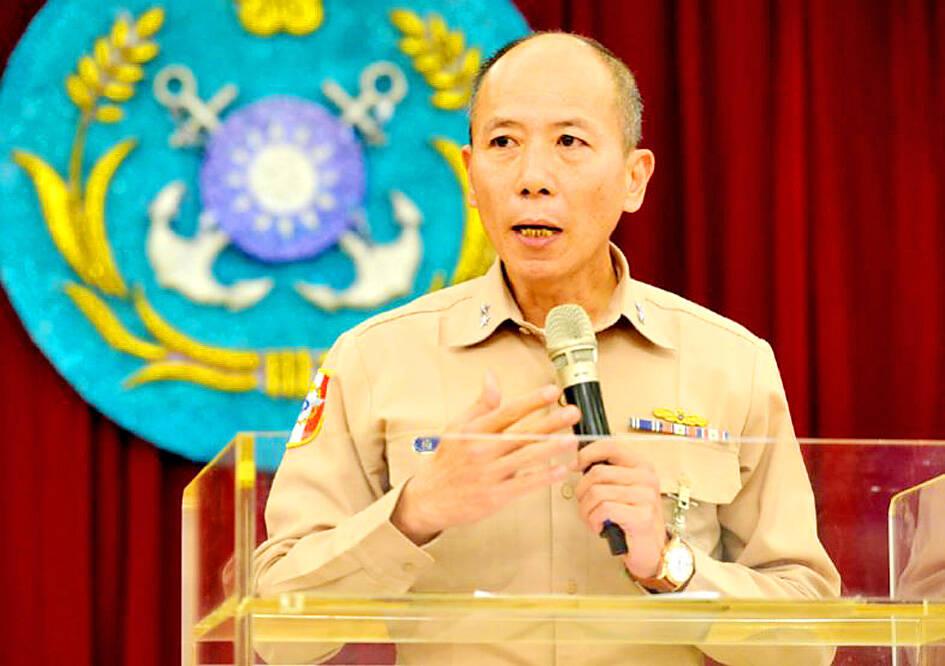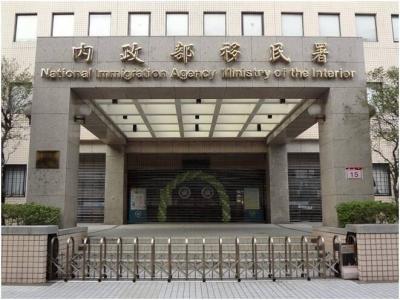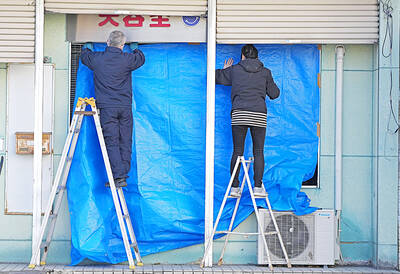This month’s annual Han Kuang military exercises are to feature six types of “gray zone” tactics used by the Chinese People’s Liberation Army (PLA) with the aim of weakening their effectiveness, Chief of the General Staff Admiral Mei Chia-shu (梅家樹) told the military today.
The 41st Han Kuang drills, scheduled from Wednesday next week through July 18, would simulate a Chinese blockade and invasion, with President William Lai (賴清德) on Tuesday saying that Taiwan is already in a “war without gun smoke."
In a speech broadcast to officers and soldiers this morning, Mei said that the six types of harassment are: legal warfare, cognitive warfare, attrition, coercion, containment and provocation.

Photo: Taipei Times file
The Chinese Communist Party (CCP) aims to use laws to challenge the international community’s ability to intervene in the Taiwan Strait, and use cognitive and psychological warfare to spread misinformation and weaken the armed forces' ability to respond, he said.
However, the army would continue to train and maintain peace and stability in the Taiwan Strait, without being provoked or contained, Mei said.
This year’s Han Kuang exercises would mobilize the 22,000 reservists, feature new weaponry and run twice as long as previous iterations, the Ministry of National Defense said earlier this week.
The exercises would be divided into three parts: simulating a PLA gray zone incursion that escalates into an invasion, practicing coastal combat and repelling an amphibious landing by the PLA, the ministry said.
The drills would include a live-fire portion, and feature a joint command structure and civil-military cooperation, it said.
They would also be combined with the Wanan air defense and Minan disaster prevention exercises to test air-raid, evacuation and urban resilience measures, the ministry said.
Taiwan's increased focus on gray zone threats and its lengthening of the Han Kuang drills' live-fire portion to 10 days have been praised by two US defense experts.
Ely Ratner, former US assistant secretary of defense for Indo-Pacific security affairs, said in an e-mail yesterday that the changes "reflect an important ongoing evolution in the strengthening of Taiwan's defenses and resilience."
“Taiwan is on the right track to contribute to deterrence,” Ratner said, adding that it should push forward with greater urgency.
John Dotson, director of the Washington-based Global Taiwan Institute, said in an e-mail that this year’s exercises would be much more meaningful.
They would be "less scripted," allowing for "a bit more spontaneity, and the confusion that comes with actual warfare," Dotson said.
In related news, 41 PLA aircraft and nine naval vessels were detected around Taiwan between 6am yesterday and 6am today, the ministry said this morning.
Thirty of the aircraft crossed the median line of the Taiwan Strait and entered Taiwan’s northern, central, southwestern and eastern air defense identification zones, it said.
Flight path charts from the ministry showed PLA aircraft routes that circled Taiwan.
The armed forces “monitored the situation and employed [patrol] aircraft, navy vessels and coastal missile systems in response to the detected activities,” the ministry said.

A small number of Taiwanese this year lost their citizenship rights after traveling in China and obtaining a one-time Chinese passport to cross the border into Russia, a source said today. The people signed up through Chinese travel agencies for tours of neighboring Russia with companies claiming they could obtain Russian visas and fast-track border clearance, the source said on condition of anonymity. The travelers were actually issued one-time-use Chinese passports, they said. Taiwanese are prohibited from holding a Chinese passport or household registration. If found to have a Chinese ID, they may lose their resident status under Article 9-1

Taiwanese were praised for their composure after a video filmed by Taiwanese tourists capturing the moment a magnitude 7.5 earthquake struck Japan’s Aomori Prefecture went viral on social media. The video shows a hotel room shaking violently amid Monday’s quake, with objects falling to the ground. Two Taiwanese began filming with their mobile phones, while two others held the sides of a TV to prevent it from falling. When the shaking stopped, the pair calmly took down the TV and laid it flat on a tatami mat, the video shows. The video also captured the group talking about the safety of their companions bathing

PROBLEMATIC APP: Citing more than 1,000 fraud cases, the government is taking the app down for a year, but opposition voices are calling it censorship Chinese Nationalist Party (KMT) Chairwoman Cheng Li-wun (鄭麗文) yesterday decried a government plan to suspend access to Chinese social media platform Xiaohongshu (小紅書) for one year as censorship, while the Presidential Office backed the plan. The Ministry of the Interior on Thursday cited security risks and accusations that the Instagram-like app, known as Rednote in English, had figured in more than 1,700 fraud cases since last year. The company, which has about 3 million users in Taiwan, has not yet responded to requests for comment. “Many people online are already asking ‘How to climb over the firewall to access Xiaohongshu,’” Cheng posted on

A classified Pentagon-produced, multiyear assessment — the Overmatch brief — highlighted unreported Chinese capabilities to destroy US military assets and identified US supply chain choke points, painting a disturbing picture of waning US military might, a New York Times editorial published on Monday said. US Secretary of Defense Pete Hegseth’s comments in November last year that “we lose every time” in Pentagon-conducted war games pitting the US against China further highlighted the uncertainty about the US’ capability to intervene in the event of a Chinese invasion of Taiwan. “It shows the Pentagon’s overreliance on expensive, vulnerable weapons as adversaries field cheap, technologically